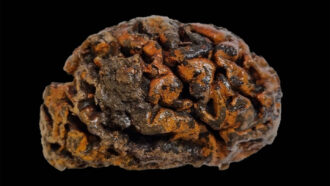Hobbits: Our tiny cousins
Skeletal remains of ancient human relatives found in Indonesia are challenging some long-accepted “truths” about human evolution
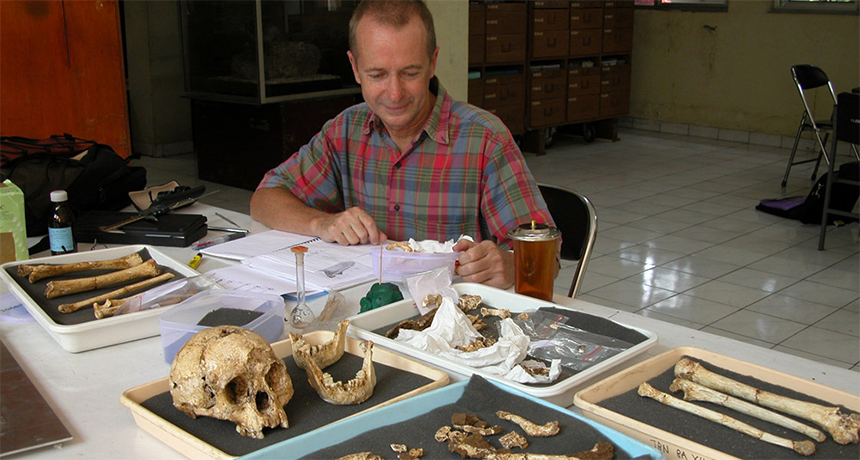
Anthropologist Peter Brown examines the Hobbit fossils.
Peter Brown
By Karl Gruber
This story starts with a tooth. One small, oddly shaped tooth — somewhat like those in your mouth. Scientists uncovered it in a cave on the island of Flores, in Indonesia. Looking old and a bit strange, this find launched an investigation to figure out where the tooth came from. Acting somewhat like private investigators, scientists puzzled over who or what left the tooth behind. This would prove to be a very, very ancient tale.
Mike Morwood, an archaeologist who had worked in Flores for a long time, brought the tooth to Australia. There, he asked Peter Brown what he thought of it. Brown is a scientist who has studied human evolution for 30 years.
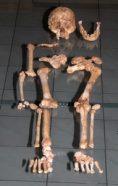
It looked a lot like a human tooth — but not quite. Its above-the-gums part, called a crown, was longer than usual. And what should have been a single cone-shaped root was broad and flat. It also looked as if it had been made from several roots pressed together.
Brown wouldn’t have been surprised if the tooth had come from a human ancestor living in Africa 1 million years ago, because they had these types of teeth. But this one was only 18,000 years old and came from Southeast Asia. Along with it, Morwood’s team had unearthed a skeleton.
Now, Brown was interested. Very interested.
Armed with not much more than a large bag of mustard seeds and a skeptical mind, Brown hopped onto a plane to visit the National Research Centre for Archaeology in Jakarta, Indonesia’s capital. That’s where that the skeleton was being kept.
At once, Brown noticed the skeleton’s lower jaw: It didn’t look human. In fact, to him, that single lower jaw contradicted 30 years of research experience and the known fossil record of people in Asia. Its shape was so unexpected, he recalls, that “I would have been less surprised if someone had found evidence of an alien spacecraft on Flores.”
Even more amazing was the skull’s size. Brown pulled out his bag of seeds and poured the mustard grains into the skull. (This is a standard method for measuring the size of a brain.) Then Brown poured the seeds out again and measured their volume: 380 cubic centimeters, or about the size of a grapefruit. That’s roughly one-third the size of an adult human’s brain.
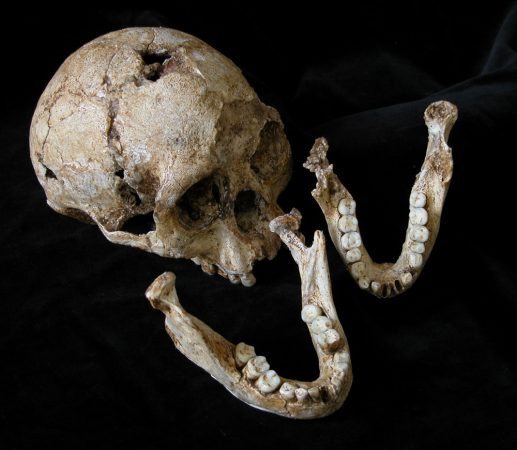
“Apparently I went very pale,” Brown recalls. He remembers thinking that what he was looking at “could not be correct.” After all, the last time two-footed human ancestors with brains this small walked the planet was 3.5 million years ago — and in Africa. So he repeated the mustard-seed measuring process several more times just to be sure he hadn’t gotten something wrong.
But the seeds didn’t lie.
It was indeed a very small skull. And as Brown collected his seeds again, his mind began racing to figure out what it meant. Could this be the skull of a pygmy?
Adults of this odd Flores tribe had apparently grown only about 1 meter tall. However, short as they were, their skeletons showed sharp differences from modern pygmies. Despite short legs and large feet, the ancient individuals appeared to have been good walkers. They had tiny brains. Yet, these human cousins — or hominids — also must have been pretty smart, because they made complex stone tools for hunting wild game.
By the end of the week, Brown realized he was looking at the remains of a small-brained, small-bodied hominid with a mix of primitive and unique features. A population of such individuals survived on Flores until the Late Pleistocene — a time when woolly mammoths and saber-toothed cats still walked the Earth. Researchers soon named the new species Homo floresiensis — but affectionately nicknamed the small individuals Hobbits.
Wrong place and time
Now let’s back up 7 million years. About this time, humanity’s ancestors came down from the trees and evolved into species that could walk on two legs. Over millions of years, new species evolved. Some of these hominids did better than others. But in the end, only one survived: Homo sapiens — us. Humans outcompeted all others.
Finding Hobbits now introduced a puzzle. These little guys looked a lot like a very old human ancestor: Australopithecus. But as far as scientists knew, Australopithecus lived only in Africa — and went extinct some 2 million years ago.
Indonesia’s Hobbits apparently lived as recently as 12,000 years ago — until a volcanic eruption killed them off. This means they lived on Flores at the same time modern humans walked around nearby Australia.
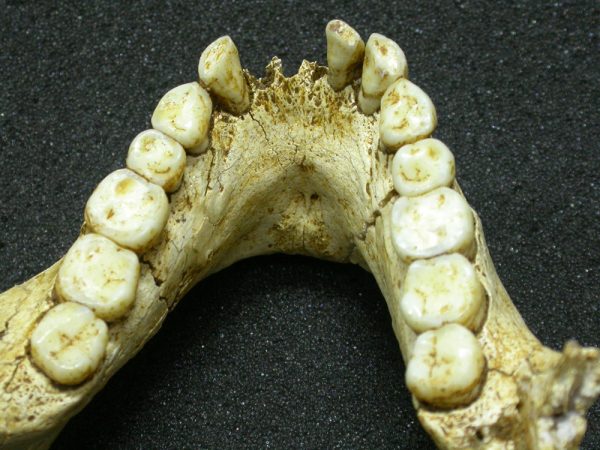
So where did the Hobbits come from?
The tiny Flores residents might have descended from Homo erectus, a human ancestor that roamed Earth about 500,000 years ago. But that hominid was much bigger than Hobbits. And its anatomy was somewhat different. If Hobbits evolved from Homo erectus, then the small Flores residents must have undergone what scientists call “insular dwarfism.” That’s when large animals living on small islands shrink over time.
But that doesn’t seem to explain the Hobbits, Brown says. Several characteristics, such as the shape of some back teeth and the wrist bones, look too primitive. They really look more like features of the African Australopithecus.
That means if Hobbits evolved from Homo erectus, they evolved backwards, regaining earlier, more primative features. And that didn’t seem likely, Brown says.
Instead, Hobbits might have evolved directly from Australopithecus. But that hominid lived far earlier and half a world away. So, the ancestors of Hobbits probably arrived in a boat, eons ago. Or they might have clung to a raft of floating vegetation after a powerful storm. This is how land animals reached many islands.
DNA should provide a quick solution to this puzzle. Genetic comparisons of Hobbits with other ancient hominids should pinpoint who their closest relatives are. Unfortunately, the Hobbits lived in a hot and humid place. That is likely the worst possible conditions for DNA preservation. And that’s why so far, nobody has retrieved good DNA from Hobbit remains.
Sick modern humans?
For his research on Homo floresiensis, Brown became an instant celebrity. But it also brought unwanted attention. For instance, he notes: “There are a surprising number of reasonably sane people who believe that very small, usually hairy and somewhat apelike, people live near them. They all tried to contact me!”
A number of news stories also questioned whether Homo floresiensis was really a new species. Maybe it was just a community of modern humans suffering from some stunting ailment. This theory remains controversial.
In 2011, researchers tested the idea. They argued that Hobbits could represent a population of humans with a disease that diminished brain size. Ralph Holloway of Columbia University in New York City and his colleagues compared the skull of Homo floresiensis with those of stunted humans.
Some of the Hobbit’s skull features match those seen in modern humans who have small heads due to disease. So, it’s possible that a disease also made the Hobbits small. The idea “cannot be totally ruled out,” Holloway says.
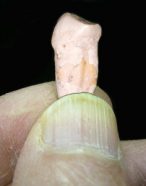
Other scientists disagree.
Colin Groves of the Australian National University in Canberra is an anthropologist — a type of scientist who studies human origins and culture. Groves points out that Holloway’s team did not compare Homo floresiensis to Australopithecus, which seems to be the Hobbits’ closest relative. They also ignored the rest of the Hobbit skeleton.
In addition, Brown says Homo floresiensis lacks distinct features seen in modern humans with diseases that make the body and brain small. And the Hobbits’ bones and teeth appear to come from healthy individuals who grew normally. If true, their primitive features strongly suggest the Hobbits truly represent a new species.
If Hobbits are a new, distinct human relative, it could force anthropologists to rethink the idea that human evolution largely happened in Africa.
“While our earliest ancestors evolved in Africa,” Brown says, “they may have left Africa much earlier than we used to think.” Once they arrived in Asia, these early ancestors may have evolved into more humanlike forms, he says: “They could have then walked back into Africa.”
POWER WORDS
anthropologist A scientist who studies human origins, behavior and culture.
human evolution The study of how the body and behavior of humans and their close relatives evolved, or changed over time.
hominid Any of the ancient humanlike species that share several important anatomical features with modern humans.
Pleistocene An ancient epoch spanning 2.6 million to 11,700 years ago. It’s a time when woolly mammoths lived. Many ice ages also occurred during this time.







